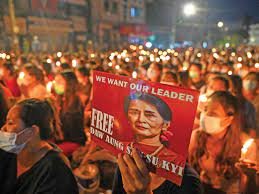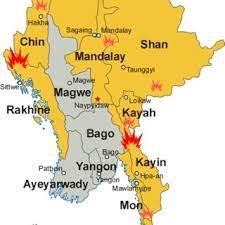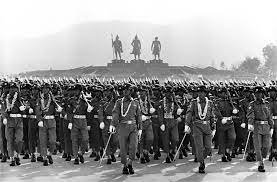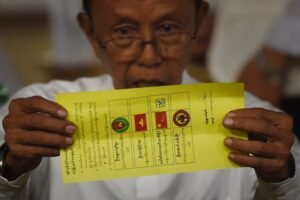As glee for a democratic election in Myanmar is fading, the country’s civil war is becoming more intense.
The Three Brotherhood Alliance claimed to have taken control of a significant trade post in the north, from which China’s military was training to enhance rescue efforts and battle preparation.
Thousands of people have been forced from their homes due to the month-long war between the rebels and Myanmar’s military regime, which has worried Beijing. Since the coup, the uprising has posed the greatest threat to Myanmar’s military. In other regions of the nation, pro-democracy militias have also stepped up their attacks.
After a concerted operation by three ethnic minority factions in late October that resulted in the capture of many towns and military facilities, Myanmar’s generals are facing their worst challenge since taking over in a coup in 2021.
The goal of the rebel forces is to seize control of a portion of the vulnerable Indian border. They have taken over control of the Mizoram border crossing, which crosses the small, hilly Indian state of India.
Following a concerted operation by three ethnic minority factions in late October that resulted in the capture of many towns and military facilities, Myanmar’s generals are facing their worst challenge since taking over in a coup in 2021.
The Three Brotherhood Alliance, which comprises the Arakan Army and Ta’ang National Liberation Army in addition to the MNDAA, has made significant progress in Operation 1027, as officially named.
Since then, Alliance troops led by the MNDAA have taken control of over 200 military installations in northern Shan State, causing the military junta to suffer its greatest defeat since it took over in a conflict in February 2021.
Just one month after beginning a concerted campaign against the military regime, a coalition of armed opposition organizations in Myanmar has taken control of another significant border crossing on the nation’s northeastern border with China.
Since the start of a coordinated operation on October 27, Kyin San Kyawt is the fourth border crossing that the opposition forces have taken control of.
The Kyin San Kyawt border gate was taken over by an offensive by the Myanmar National Democratic Alliance Army (MNDAA), a member of the Three Brotherhood Alliance, according to MNDAA officials and MNDAA-affiliated media agencies.
Many experts claim that the alliance and other “resistance forces” control a significant portion of the nation as “The three Brotherhood Alliance,” which is composed of the Ta’ang National Liberation Army (TNLA), the Arakan Army (AA), and the Myanmar National Democratic Alliance Army (MNDAA), have launched a massive offensive in northern Myanmar.
They claim that the developments are a reflection of the quickly “shifting geographies of the power” in Myanmar and that much would depend on China’s and India’s responses.
Myanmar Civil War
There have always been many moving parts to the conflict in Myanmar, including allies and rivalries. The ethnic states are rich in valuable forest products, poppies, precious timbers, minerals, and stones. The Tatmadaw committed crimes, including mass rape, murder, torture, and forced displacement, in order to gather these resources and sell them to China, the main market. This led to a great deal of fighting.
Over time, different ethnic armies have agreed to ceasefires or changed sides in exchange for “taxes” paid on the extraction of natural resources. China backs the Tatmadaw to safeguard its assets. However, China has also supported a number of armed ethnic groups over the years.
For instance, the Tatmadaw and the UWSA, which is economically connected to China, have a cease-fire agreement. However, as is frequently the case in this extraordinarily peculiar conflict, the UWSA is also producing and supplying armaments to other ethnic rebel organizations that are still engaged in combat with the Tatmadaw.
The junta is under pressure as its forces fight opposition militias, particularly in the nation’s rural areas, and has lost numerous bases since the Three Brotherhood Alliance (TBA) launched coordinated attacks in late October. In addition to imprisoning NLD leaders, the junta used crackdowns to quell the protests that followed the coup in an effort to undo the political reforms that had occurred in Myanmar since its limited democratization in 2010.
However, this has only served to strengthen the NLD and its supporters, who established an exiled National Unity Government (NUG) and rebel militias known as the Peoples’ Defense Forces. These forces, along with ethnic groups from the Karen, Kachin, Chin, and Karenni, overthrew the junta while its political leaders engaged in dialogue platform for Myanmar’s federal and democratic charter.
The conflict in Myanmar, often known as Burma by the opposition, started in 1949, not long after the nation separated from the United Kingdom. There are 135 distinct ethnic groupings in Myanmar, and its 54 million citizens speak at least 111 languages. Around 68% of the population is Burman, and they control the majority of the nation’s military and governmental authority.
Having about 30,000 soldiers, the United Wa State Army (UWSA) is regarded as the most formidable force, equipped with heavy machinery, helicopters, and its own facilities for producing weapons and other gear.
Who are Tatmadaw?
On February 1, the opposition, backed by a coalition of eighteen unions and the vast majority of civilians, called for a national strike in response to the two-year anniversary of Burma’s military takeover. This brought the already struggling economy of the nation to a complete halt.
The number of people whose lives have been interrupted or ended by the military dictatorship has increased as hundreds were detained and thousands were sacked.
Fighting has expanded throughout the majority of the nation since the military takeover in 2021, turning a low-intensity struggle into a full-fledged civil war. Thus far, opposition party members, journalists, and other regime critics have been among the 17,572 individuals arrested and 2,940 civilians killed by government armed forces, known as the Tatmadaw.
Tatmadaw, which translates to “armed forces” in Burmese, has come to represent the current military regime due to its immense influence both domestically and internationally. A standing army was a feature of the Burmese kingdom for centuries until it was dismantled during British administration.
Originating in 1941, a group of rebels led by Aung San, who is seen by many Burmese as the spiritual “Father of the Nation”—founded the Burma Independence Army (BIA), which is the beginning of Tatmadaw. He was the father of Aung San Suu Kyi.
Aung San Suu Kyi was accused of a number of infractions right away following the coup, including bringing in walkie talkies. After more accusations were made during secret proceedings, she was given a four-year prison sentence in November 2021.

After additional trials and sentencing, she faced 33 years in jail at the end of 22. She is 77 years old, and her chances of survival are slim. Thus, the junta has put an end to their political opposition, but the people are still fighting. And the military keeps answering with force.
The National Election in Myanmar
The announcement made by the military regime in Myanmar last month that national elections will proceed, albeit without a specified date, shocked the whole world.
Although the State Administration Council, the military junta, initially pledged to hold elections by August 2023, there is currently little chance of a free and democratic electoral process. Only parties supported by the military remain in the race after all opposition parties were banned.
The junta’s hold on the northern Shan State has been weakened by the TBA’s member groups, the Myanmar National Democratic Alliance Army, the Ta’ang National Liberation Army, and the Arakan Army, among others, who joined the civil war and began hostilities in Rakhine State.
Aung San Suu Kyi, the winner of the Nobel Peace Prize, led the National League for Democracy (NLD), one of the 40 groups on the list that the junta said had been banned in March. The NLD, which has been allowed to participate in two previous elections, is viewed as the hope for democracy.
The 39 outlawed parties that were still in existence were mostly smaller, anti-junta ethnic minority parties that were not expected to succeed nationally. The Union Solidarity and Development Party (USDP), a military proxy in elections, is the most formidable contender among the parties still in the running. This party, led by President Thein Sein at the time, administered the nation in a hybrid military-civilian system.
If re-elected, the USDP will serve as a public face of legitimacy, legislating policies supporting the military junta.
A Breif History
When the Union of Burma was founded in 1947, many ethnic groups were reluctant to join for fear of unfair treatment at the hands of the Burmese.
Officially, each of the seven main minority groups—Kachin, Kayah (Karen), Kayin, Mon, Rakhine (Arakan and Rohingya), Shan, and Chin—has its own state. These groups range greatly in population size, with Rakhine having roughly 3.2 million and Shan and Karen having 5 to 6 million apiece. Following its founding in 1947, the Union of Burma faced resistance from numerous ethnic groupings.
The ethnic communities believed that the Burmese majority was ignoring their cultural and political rights and marginalizing them. The Shan, Karen, and other minority groups were worried that their languages were being silenced and that they were not being granted fair ownership over the resources located in the ethnic zones. The first people to clash with the Burmans were the Karen.
A large number of Karen people became Christians in the 1800s. They consequently enjoyed a closer relationship with the British. In addition to sending their kids to the Baptist College in Yangon and British schools in Karen State, they also urged them to learn English. The Karen fought alongside the British against the Japanese during World War II.
The Karen people were the first in the newly formed Union of Burma to assert their rights following Burma’s independence from Britain. The Karen independence movement began in 1948 when students began to demonstrate in the streets.
Soon after, demands for increased autonomy or complete independence from the Burmese government were made by other ethnic minority groups. As early as 1949, the first ethnic group to declare war on the Burmese military was the Karen National Union (KNU).
There has almost always been composed in the nation since the Karen started their independence campaign, since other ethnic groups have formed armies and joined the conflict. In the last 70 years, more than 40 armed groups have emerged.
While some did not last long, others have persevered and are still going strong. The Shan State Army (SSA), which has been in operation since roughly 1964, is thought to have at least 12,000 men, compared to roughly 15,000 in the KNU. 30,000 men make up what may be the largest army, the Arakan Army.
Considered the father of Burmese independence, Aung San (1915–1947) is credited for starting the political roots of the struggle. He did not survive to see his ambition come true because he was assassinated the year the Union of Burma was established.
Since then, the nation has been ruled by the military, with Aung San’s daughter, Aung San Suu Kyi, acting as the symbol of democracy and the person everyone looked to for a free and democratic political system.
The National League for Democracy (NLD) was led by Aung San Suu Kyi. A regulation barring candidates with foreign wives or children prevented her from running for president. Her two sons, who are British, and her late husband have not returned to the UK for security reasons. He passed away in 1999.
Recent Election in Myanmar
Elections were permitted by the generals in 2015, Aung San Suu Kyi led the National League for Democracy Party (NLD) to a decisive win. She held the position of State Counselor for Myanmar, although being prohibited from running for president. Her situation was exacerbated, nevertheless, because the State Counselor was acknowledged as the nation’s de facto leader by both the populace and foreign heads of state. However, the NLD rule was merely symbolic in reality.
The military rewrote the constitution in 2008, granting them the authority to veto any legislation that they disagreed with by appointing 25% of the parliament’s seats. The political climate was far from ideal, but it was the closest thing Burma has ever had to a democratic, civilian government. The conflict subsided as people hoped that changes will occur in the future.
In 2020, there were new elections, and this time the NLD won by an even wider majority. The generals took over the government shortly after, in February 2021, annulling the results and arresting multiple lawmakers.
As a result, violence returned across the nation. In contrast to earlier conflicts, a large number of Burmese, including those who lived in cities, took up weapons during this one. Once viewed by city people as terrorist organizations, the ethnic armies were now seen by many as freedom fighters.
Burmese frequently went looking for training from ethnic resistance armies in order to combat the Tatmadaw.
Take Of Nuclear Powers on Myanmar
As a result of the military takeover, the US, UK, Canada, and EU imposed sanctions on Myanmar in 2021. Myanmar’s GDP is nevertheless predicted to expand by 3% this year in spite of this. Myanmar, on the other hand, has resorted to an unexpected partner – Russia.
At the moment, Myanmar supports the invasion of Ukraine and buys supplies and weapons from Russia. Although the relationship is a concerning move from a diplomatic standpoint, Russia’s ability to support the Myanmar junta in maintaining power may be weakened by the country’s current volatility.
The Tatmadaw and the NUG continue to be at war, but the military junta backed by Russia is expected to hold onto power for a very long period. It appears that there is still, albeit very little, hope for democracy until the international community—ASEAN(The Association of Southeast Asian Nations) in particular—chooses to take stronger action against Myanmar or the military junta steps aside, as it did for the 2015 elections.
India has cautiously nurtured ties with the junta in an effort to undermine China’s influence in Myanmar, even while it has supported democratic reforms. These connections appear to have been important in enabling New Delhi to let junta soldiers escape the turmoil in Chin State into Mizoram and to help them return across the Moreh border.
However, given that the junta is returning to its oppressive methods of bombing civilian targets in an attempt to crush the growing opposition, even as the NUG is becoming more legitimate and promising a more federal, democratic Myanmar, it is past time for New Delhi to reevaluate its relationship with the junta.
More than a million people have been internally displaced since the uprising. 80,000 people have reportedly left the nation altogether. Only individuals residing in refugee camps abroad are included in this figure. The actual figure could be in the hundreds of thousands.















Comments 1